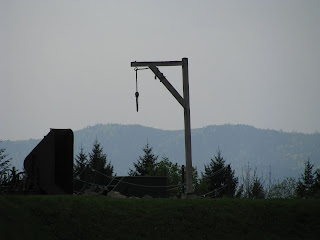

My last day in France was spent visiting Simserhof, an underground bunker that was part of the famed and ill-fated Maginot Line and the Bitche Citadel (you didn’t know they had their own fort in France?). The Maginot Line, as we all know, was a line of “impenetrable” underground fortifications built along the France’s eastern border. While a great defense against an invading Napoleonic Army, they were useless after the German end run through the “impenetrable” Ardennes Forest and supply lines were cut off.
The Maginot Line, as we all know, was a line of “impenetrable” underground fortifications built along the France’s eastern border. While a great defense against an invading Napoleonic Army, they were useless after the German end run through the “impenetrable” Ardennes Forest and supply lines were cut off.
 The fort cannot go to the battle; the battle must come to the fort. It was a failure of the French Army to see the future of warfare and a failure to learn the lessons of the Franco-Prussian war, where French forts failed to carry the day.
The fort cannot go to the battle; the battle must come to the fort. It was a failure of the French Army to see the future of warfare and a failure to learn the lessons of the Franco-Prussian war, where French forts failed to carry the day. If the French had built tanks instead of the Maginot Line, June 1940 might have gone differently.
If the French had built tanks instead of the Maginot Line, June 1940 might have gone differently.
Yesterday morning, I left my hotel at 7:15am (1:15am EDT) for the Frankfurt Airport to begin my journey home. I would arrive back home at 11:00 pm EDT. My next trip is set for June 9th to June 16th, when I take my friend Bill “Homer” Crossett west to Mount Rushmore. While filling out my U.S. Customs entry card, I noticed the exit stamp from Germany. Life is funny that way.
 The Maginot Line, as we all know, was a line of “impenetrable” underground fortifications built along the France’s eastern border. While a great defense against an invading Napoleonic Army, they were useless after the German end run through the “impenetrable” Ardennes Forest and supply lines were cut off.
The Maginot Line, as we all know, was a line of “impenetrable” underground fortifications built along the France’s eastern border. While a great defense against an invading Napoleonic Army, they were useless after the German end run through the “impenetrable” Ardennes Forest and supply lines were cut off.
 The fort cannot go to the battle; the battle must come to the fort. It was a failure of the French Army to see the future of warfare and a failure to learn the lessons of the Franco-Prussian war, where French forts failed to carry the day.
The fort cannot go to the battle; the battle must come to the fort. It was a failure of the French Army to see the future of warfare and a failure to learn the lessons of the Franco-Prussian war, where French forts failed to carry the day. If the French had built tanks instead of the Maginot Line, June 1940 might have gone differently.
If the French had built tanks instead of the Maginot Line, June 1940 might have gone differently.Yesterday morning, I left my hotel at 7:15am (1:15am EDT) for the Frankfurt Airport to begin my journey home. I would arrive back home at 11:00 pm EDT. My next trip is set for June 9th to June 16th, when I take my friend Bill “Homer” Crossett west to Mount Rushmore. While filling out my U.S. Customs entry card, I noticed the exit stamp from Germany. Life is funny that way.

















































